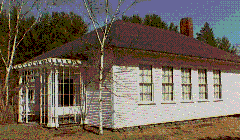Mothers' and Daughters' Club House |
|
|
Site: N09-6
|
National Register Nomination Information:
DESCRIPTION: The Mothers' and Daughters' Club House is a building designed by the famed New York architect Charles A. Platt in 1901. This building was planned and designed to meet the specific needs of the, then newly formed, Mothers' and Daughters' Club of Plainfield, N.H. The Club needed space for its rug industry as well as a meeting place. The Club House is a one-story, 5 x 1 bay, white clapboarded structure, 45' x 26' with a pyramidal hipped roof. The interior consists of one large meeting-work room with large windows on the north and south sides. A large fireplace is at the east end of the room. Attached to the east end of the building is a small kitchen, a utility-storage room and privy. A 15' x 15' woodshed is attached to the main building on the east end. The Mothers' and Daughters' Club House has not been altered appreciably since it was built. A trellised front porch was added soon after it was built. In recent years, a gas heating system was installed to replace wood heat. A hand pump and well, used for many years, was replaced by town water in 1971. Painting and papering have been done at infrequent intervals. A polished hardwood floor has been maintained. The Club House as designed by the noted architect, Charles A. Platt, exemplifies a simple structure, erected for specific use. The pleasant meeting room is dominated by a large fireplace, flanked by balanced doors leading to the accessory rooms. Large windows, in symmetrical arrangement along the north and south walls, fill the room with light. The high ceiling is simplicity itself; the gently rounded four corners being the only hint of special design. Some of the paintings and etchings, which have been there since the beginning, still adorn the walls. The building reflects a simple, attractive design planned to provide light, pleasant space for club meetings, work sessions, and social gatherings.
The Mothers' and Daughters' Clubhouse is one of the earliest women's clubhouses in the United States which remains in original condition. Built near the beginning of a strong national movement favoring increased independence and broadened activity for women, the building is a rare survivor of an architectural form that was occasionally built to house such activity. Constructed in direct response to an arts and crafts program for local women, the clubhouse is also an important landmark in the resurgence of American handicrafts, a movement which had strong beginnings in New England and remains especially vigorous in the region today.
Architecture:
Art:
In this context, The Mothers' and Daughters' Club established the Mothers' and Daughters' Industries in 1900. The first effort of the Industries was in the production of woven rugs, a form of floor covering that was traditional in New Hampshire. Local women cut and dyed the cloth strips for these rugs at home and, after their clubhouse was built, brought them to the building to be woven and sewn into floor coverings. The clubhouse, then lighted by kerosene lamps and by its expansive windows, housed the antique looms and work tables upon which these strips were woven into small rugs or sewn together into full-width carpets of many sizes. Club members also fashioned curtains, bedspreads and table coverings which were sold throughout the United States and even overseas. Some of the profit from this production went to the club's treasury, while some augmented the private income of individual club members.(5) The Mothers' and Daughters' Industry thus established precedents that led to the incorporation, thirty years later, of the League of New Hampshire Arts and Crafts, the first statewide handicraft organization in the United States and still a leading force in the American craft movement.
Social/Humanitarian:
The establishment of clubs by women, for the exclusive membership of women, was a phenomenon of the late nineteenth century in New England. The first such organization in New Hampshire was founded in 1873 and, like many others that followed, it was devoted to the study of literature. By the late 1800s, however, women's groups had begun to diversify and a few had found the means to build clubhouses for themselves. The first such building in New Hampshire, and perhaps in the nation, was constructed in 1896. The Mothers' and Daughters' Clubhouse, built only five years later and essentially unaltered since its construction, is certainly one of the earliest such buildings in the United States and survives as a monument to one of the most far-reaching social movements of the turn of the century.
NOTES:
Ruggles, (Mrs.) G. S. Mothers' and Daughters' Industry. This is a small paper booklet published by the Mothers' and Daughters' Club, December 1, 1904. The N.H. State Library has a copy. Bishop, Lucy F. The Mothers' and Daughters' Club Through the Years. 1972. This is an unpublished manuscript written for the Club's seventy-fifth anniversary celebration. There is a copy in the Plainfield Library. Correspondence dated August 8, 1980 and November 14, 1980 from Mr. James L. Garvin, Curator, N. H. Historical Society, 30 Park Street, concord, N.H. 03301. Miscellaneous, uncatalogued, boxed papers, records, account books, etc., of the Mothers' and Daughters' Club now stored at the homes of Mrs Mary Cassedy and Mrs. Beatrice Clark of Plainfield.
DATE ENTERED: March 11, 1982.
|
BACK TO NATIONAL REGISTER PROPERTIES
